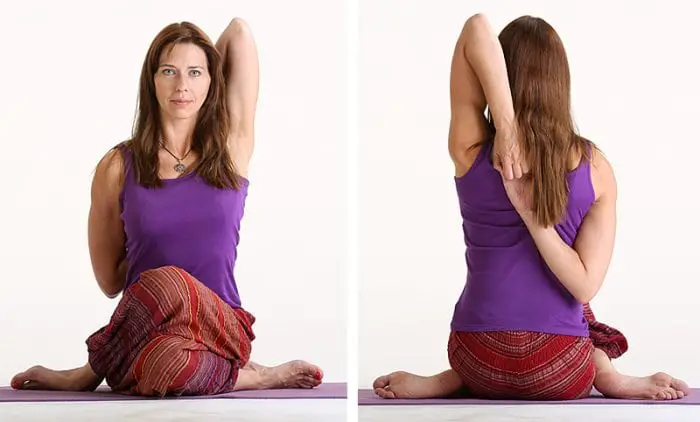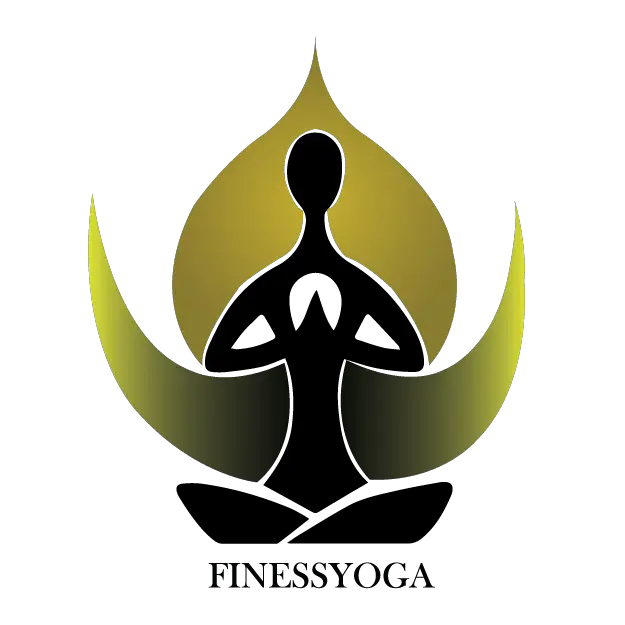Gomukhasana commonly known as Cow Face Pose in English is a seated pose. The Sanskrit name Gomukhasana is derived from three words, the first, Go which means Cow, the second, Mukha which means Face or Mouth, and the third, Asana which means posture.
The Sanskrit word Go also means Light, hence the name Gomukhasana can also be understood as an asana representing the Divine Light in the head. In this asana, the whole body seems to be in the shape of a cow’s face, the thighs and calves take a shape that is wide at one end and taper at the other.
This asana gives an intense stretch to the limbs and the back and strengthens the back and the chest muscles, along with it there are several other benefits of Gomukhasana, but first, let’s begin by knowing the steps to practice Gomukhasana.
 Steps to practice Gomukhasana (Cow Face Pose)
Steps to practice Gomukhasana (Cow Face Pose)
It is very important to know the right alignment of the body in an asana to avoid the formulation of any kind of injury and to attain the maximum benefits of the asana. Here are the steps to practice Gomukhasana correctly:
Starting Position: Dhyana Virasana (Hero’s Meditation Pose)
- Relax the body. Take 3 long deep breaths.
- Stretch the left arm to the side and fold it behind the back.
- Stretch the right arm up above the head and fold it over the right shoulder.
- Keep the back of the left hand in contact with the spine whereas the palm of the right hand should rest against the spine.
- Clasp the fingers of both hands behind the back.
- Keep the raised elbow behind the head in a pose in which the head presses against the inside of the raised arm.
- The spine should remain erect and head straight.
- Keep the eyes closed and stay in the same position for up to a minute or a few seconds.
- Then unclasp the hands, straighten the legs and relax the body.
- Then repeat the same by keeping the left knee uppermost and the left arm over the left shoulder.
It is recommended to practice Titli Asana (Butterfly pose) and Adho Mukha Svanasana (Downward Facing Dog Pose) after practicing Gomukhasana as they increase its effectiveness.
Precautions for Gomukhasana (Cow Face Pose)
The precautions for Gomukhasana to be kept in mind for a safer practice are given below:
- Avoid straining the body beyond the limits as it may cause back pain or spinal injury.
- Consult a yoga trainer, if you are a beginner as this asana requires a lot of flexibility.
- Do not overburden your body, if you are obese. Practice it according to the comfort level of the body.
- People suffering from any of this condition should avoid practicing this asana: shoulder, back, neck or joint pain, migraine, or spinal disorders.
Benefits of Gomukhasana (Cow Face Pose)
The health benefits of Gomukhasana which one can experience gradually with regular practice are as follows :
- Excellent for inducing relaxation.
- Beneficial in curing sexual ailments.
- Improves the functioning of the kidney.
- Induces the flow of energy and refreshes the body.
- Improves the body posture by opening the chest area.
- Helpful in getting rid of stress, tension, fatigue and anxiety.
- Relieves a backache, sciatica, rheumatism, arthritis and joint pain.
- Alleviates the cramps in the legs and strengthen the leg muscles.
- Cure frozen shoulder and helpful in removing the general stiffness of shoulders and neck.
Stay healthy stay strong and get the best out of life.
Like this post? If yes, then don’t forget to share it with your friends on Facebook, Twitter, and Google Plus!
Here are a few hand-picked articles for you:
- Pawanmuktasana (Wind Relieving Pose) steps, precautions & benefits.
- Ashwa Sanchalanasana (Equestrian Pose) steps, benefits & precautions.
- Purvottanasana (Upward Plank Pose) steps, precautions & benefits.
- Marjariasana (Cat Stretch Pose) steps, precautions & benefits.
- Tadasana (Mountain Pose) meaning, steps, precautions and benefits
Please feel free to ask and suggest anything in the comment section.
Thanks for reading. Visit again.

Fantastic web site. A lot of strategies in this article. I am just delivering the item to a couple of good friends.
Very generous of you to share with your friends. Thanks a lot!